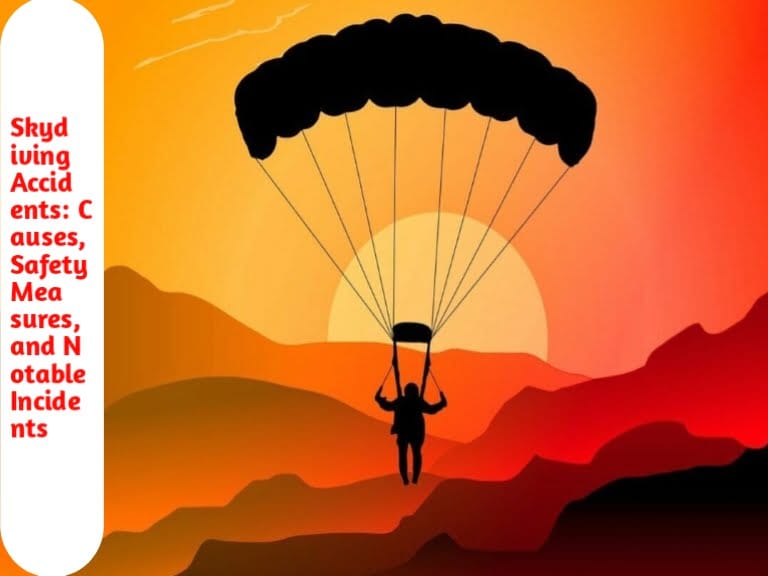Skydiving Accidents: Causes, Safety Measures, and Notable Incidents
Skydiving is an exhilarating sport that offers a unique thrill and a sense of freedom. However, it comes with inherent risks. This article explores the causes of skydiving accidents, the safety measures in place to prevent them, and notable incidents that have shaped the sport’s safety protocols.
Causes of Skydiving Accidents
Skydiving accidents can occur due to various factors, ranging from human error to equipment failure. Understanding these causes is crucial for improving safety and reducing the risk of accidents.
- Human Error: The most common cause of skydiving accidents. Mistakes can occur during any part of the jump, including improper body positioning, delayed parachute deployment, or incorrect landing techniques.
- Equipment Failure: While rare, equipment malfunctions can lead to accidents. This includes issues with the parachute not deploying correctly, reserve parachutes failing, or problems with the harness.
- Weather Conditions: Adverse weather conditions such as high winds, rain, or turbulence can make skydiving more dangerous. Jumpers must be aware of weather forecasts and avoid jumping in unsuitable conditions.
- Medical Conditions: Health issues, particularly those affecting the heart or consciousness, can lead to accidents during a jump. Skydivers should undergo medical evaluations to ensure they are fit for the sport.
- Collisions: Mid-air collisions with other jumpers or aircraft are rare but possible. Proper coordination and adherence to safety protocols can mitigate this risk.
Safety Measures in Skydiving
Reed more… Grayson Rodriguez: Rising Star in Baseball
Despite the risks, skydiving has become significantly safer over the years due to advancements in technology and stringent safety protocols. Here are some key safety measures:
- Rigorous Training: All skydivers, especially beginners, undergo extensive training to learn proper techniques and emergency procedures. This includes simulated jumps, body positioning, and parachute deployment.
- Equipment Checks: Regular inspection and maintenance of equipment are crucial. Parachutes, harnesses, and reserve systems are checked for wear and tear and proper functionality.
- Automated Activation Devices (AAD): These devices automatically deploy the reserve parachute if the skydiver is unable to do so at a certain altitude, adding a critical layer of safety.
- Weather Monitoring: Skydiving centers closely monitor weather conditions and only allow jumps when it is safe to do so. This includes checking wind speeds, visibility, and potential turbulence.
- Health Screenings: Skydivers are often required to provide medical certificates ensuring they are in good health and capable of handling the physical demands of the sport.
Notable Skydiving Incidents
- Felix Baumgartner’s Stratos Jump (2012): While not an accident, this notable event involved significant risks. Baumgartner successfully completed a jump from the stratosphere, reaching speeds of 843.6 mph and demonstrating the importance of advanced safety measures in extreme skydiving.
- Norfolk Skydiving Accident (2016): A tragic incident where two skydivers collided mid-air during a formation jump in Norfolk, UK, resulting in the death of one jumper. This highlighted the need for strict adherence to safety protocols and coordination among jumpers.
- Sebastian State Park Incident (2021): In Florida, a skydiver experienced a parachute malfunction and had to rely on the reserve parachute, which fortunately deployed correctly, preventing a fatal accident. This incident underscored the importance of equipment checks and AADs.
Conclusion
Skydiving, while thrilling, involves significant risks that can lead to serious accidents. Understanding the causes of these accidents and adhering to stringent safety measures can help mitigate these risks. The sport has seen considerable advancements in safety protocols and equipment, making it safer than ever before. However, the key to minimizing accidents lies in continued vigilance, proper training, and strict adherence to safety guidelines.
Skydiving enthusiasts and professionals must remain committed to these practices to ensure that the sport remains as safe as possible for everyone involved.
How did you like the information given in our article today, please tell us in the comment section and for more such posts, follow our page The News House, thank you
